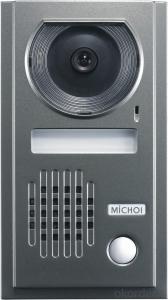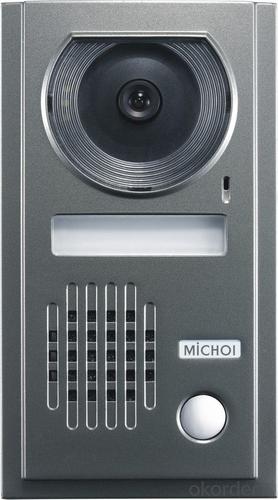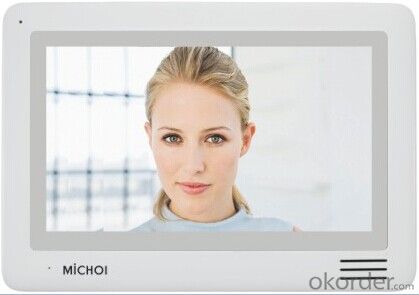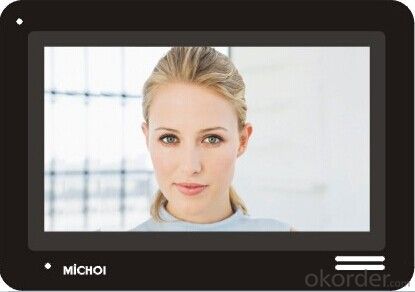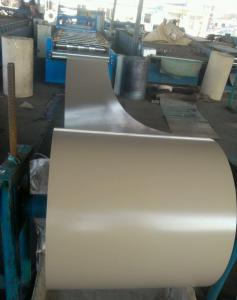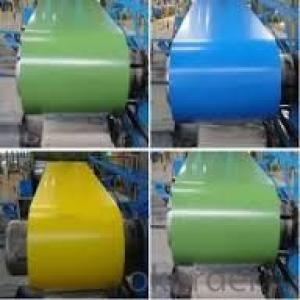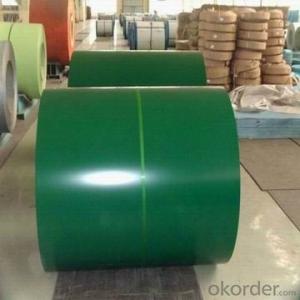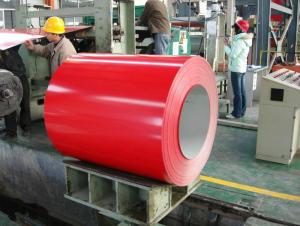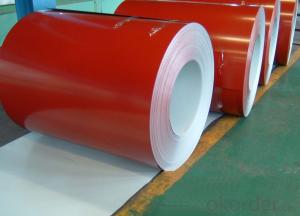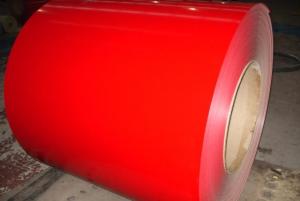Color Coated PPGI/PPGL Steel Coil or Steel Sheets
- Loading Port:
- China Main Port
- Payment Terms:
- TT or LC
- Min Order Qty:
- 50 m.t.
- Supply Capability:
- 20000 m.t./month
OKorder Service Pledge
OKorder Financial Service
You Might Also Like
1. PPGI/PPGL Steel Sheets/Coil Description:
With Galvanized as base material, after pretreatment (degrease and chemical treatment ) and liquid dope with several layers of color, then after firing and cooling, finally the plate steel is called pre-painted galvanized (aluzinc) steel. Pre-painted galvanized steel is good capable of decoration, molding, corrosion resistance. It generally displays superior workability, durability and weather resistance.
2.Main Features of the Pre-Painted Galvanized/Aluzinc Steel Sheets/Coil:
• Excellent process capability
• Smooth and flat surface
• Workability, durability
• Excellent heat resistance performance
• High strength
• Good formability
• Good visual effect
3.PPGI/PPGL Steel Sheets/Coil Images
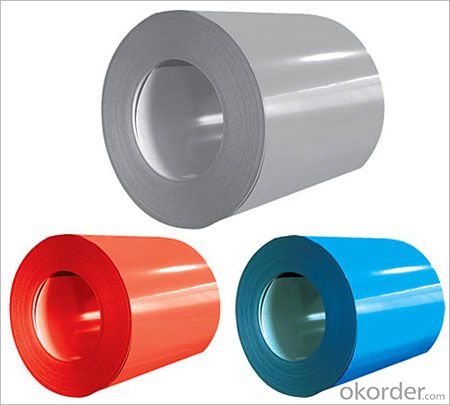
4.PPGI/PPGL Steel Sheets/Coil Specification
Standard: SAE, ASTM, BS, DIN, GB, JIS
Grade: DX51D, DX52D ,DX53D
Thickness: 0.17-2.3mm
Brand Name: KMRLON
Model Number: coil
Type: Steel Coil
Technique: Cold Rolled
Surface Treatment: Coated
Application: Boiler Plate
Special Use: High-strength Steel Plate
Width: 20-1250mm
Length: customized
commoidty: pre-painted galvanized steel coil
Thickness: 0.13-4.0mm
width: 20-1250mm
zinc coating: 40-180g/m2
printing thickness: top side: 20+/-5 microns, back side: 5-7 microns
color: all RAL color
surface treatment: color coated
coil weight: 4-6tons
coil ID: 508/610mm
packaging: standard seaworthy packing
5.FAQ of PPGI/PPGL Steel Sheets/Coil
1. What’s the application of this product?
Roof, roof structure, surface sheet of balcony, frame of window, etc.
2. What’s the brand of the paint?
We use the best brand of all of the word—AKZO.
3. How to guarantee the quality of the products?
We have established the international advanced quality management system,every link from raw material to final product we have strict quality test;We resolutely put an end to unqualified products flowing into the market. At the same time, we will provide necessary follow-up service assurance.
4. How long can we receive the product after purchase?
Usually within thirty working days after receiving buyer’s advance payment or LC. We will arrange the factory manufacturing as soon as possible. The cargo readiness usually takes 15-25 days, but the shipment will depend on the vessel situation.
- Q: Can you use regular welding rods when welding stainless steel?Thank you.
- You would use stainless steel rod. I have used stainless safety wire that you can buy at the hardware store or Harbor Freight. (Assuming you are TIG welding). I have found that for small jobs it works quite well.
- Q: What we have to keep in mind before buying a steel building?
- Before okorder /... Hope this will prove helpful to you.
- Q: What are the different types of steel coil loading and unloading methods?
- There are several different types of steel coil loading and unloading methods, including overhead crane loading and unloading, forklift loading and unloading, coil car loading and unloading, and conveyor loading and unloading. Each method has its own advantages and suitability depending on the specific requirements and constraints of the steel coil handling process.
- Q: I am wondering if i can use my western guitar as a kind of steel-guitar, read something about it on Wikipedia.
- If you decide to get a true pedal steel, plan on spending some big money. Look on eBay for a Carter Starter. It will be the best guitar to start on...and not outgrow too fast.
- Q: How are steel coils tested for quality?
- Steel coils are tested for quality through a series of rigorous inspections and tests. These include visual inspections to identify any surface defects, dimensional measurements to ensure proper size and shape, and mechanical tests such as tensile strength and hardness tests. Additionally, non-destructive testing methods like ultrasonic testing and magnetic particle inspection are used to detect internal defects or cracks. These comprehensive quality checks ensure that steel coils meet the required standards and are fit for their intended applications.
- Q: How are steel coils used in the manufacturing of food processing equipment?
- Steel coils are used in the manufacturing of food processing equipment to create sturdy and durable structures. These coils are often formed into various shapes and sizes to serve as the framework for machines such as mixers, grinders, ovens, and conveyors. The strength and resilience of steel make it an ideal material for withstanding the demanding conditions of food processing, ensuring the safety and efficiency of the equipment.
- Q: What are the different types of steel coil transport methods?
- There are several different types of steel coil transport methods, including flatbed trucks, coil racks, coil cradles, and coil trailers. Each method offers unique advantages and is used based on factors such as coil size, weight, and transportation requirements.
- Q: The Iron and Steel Corporation of Great Britain (1949) or Iron and Steel Bill was introduced in 1949 during the Labour post-war Government.What was it introduced for?
- It was a holding company that originally had 107 companies who manufactured iron or steel products in Great Britain.
- Q: How are steel coils used in the production of metal bridges?
- Due to their versatility, strength, and durability, steel coils are a crucial element in the manufacturing of metal bridges. These coils, typically made from high-quality steel alloys, provide the necessary structural integrity required for bridge construction. To begin the process of using steel coils for bridge production, they undergo a series of manufacturing techniques. The coils are uncoiled and straightened to eliminate any distortions or bends. They are then precisely cut into lengths according to the specifications of the bridge design. Once the steel coils have been processed, they are transformed into various structural components used in bridge construction. These components include beams, girders, trusses, and plates. Beams and girders serve as the primary support structure of the bridge, while trusses provide additional support and stability. Plates are used for the bridge deck, providing a surface for vehicles and pedestrians to travel on. Steel coils also play a critical role in the fabrication of bridge connections and joints. These connections are essential for transmitting loads and forces throughout the bridge structure, ensuring its stability and safety. Steel coils are utilized in the creation of various connection elements, such as bolts, nuts, washers, and welded sections. Furthermore, steel coils are commonly employed in the production of bridge reinforcements. Rebar, which is used to strengthen concrete elements within the bridge, is manufactured from steel coils. By enhancing the load-bearing capacity and resistance to bending and tension, these reinforcements strengthen columns, piers, and abutments. In addition to their structural applications, steel coils are also utilized for protective coatings on metal bridges. They can be coated with specialized materials like zinc, epoxy, or paint to prevent corrosion and extend the bridge's lifespan. These coatings are especially important in harsh environments with high levels of moisture, chemicals, and weathering factors, as they help maintain the bridge's structural integrity. Overall, steel coils are the foundation of metal bridge production. They are transformed into various components, connections, reinforcements, and protective coatings that ensure the bridge's strength, durability, and longevity.
- Q: What are the common coil coating materials?
- The common coil coating materials include polyester, polyvinylidene fluoride (PVDF), polyurethane, epoxy, and acrylic.
Send your message to us
Color Coated PPGI/PPGL Steel Coil or Steel Sheets
- Loading Port:
- China Main Port
- Payment Terms:
- TT or LC
- Min Order Qty:
- 50 m.t.
- Supply Capability:
- 20000 m.t./month
OKorder Service Pledge
OKorder Financial Service
Similar products
Hot products
Hot Searches
Related keywords
